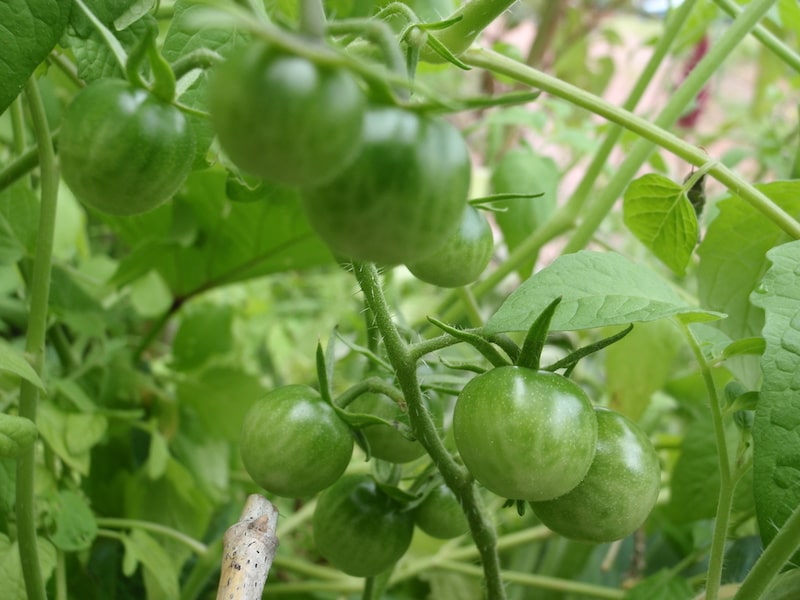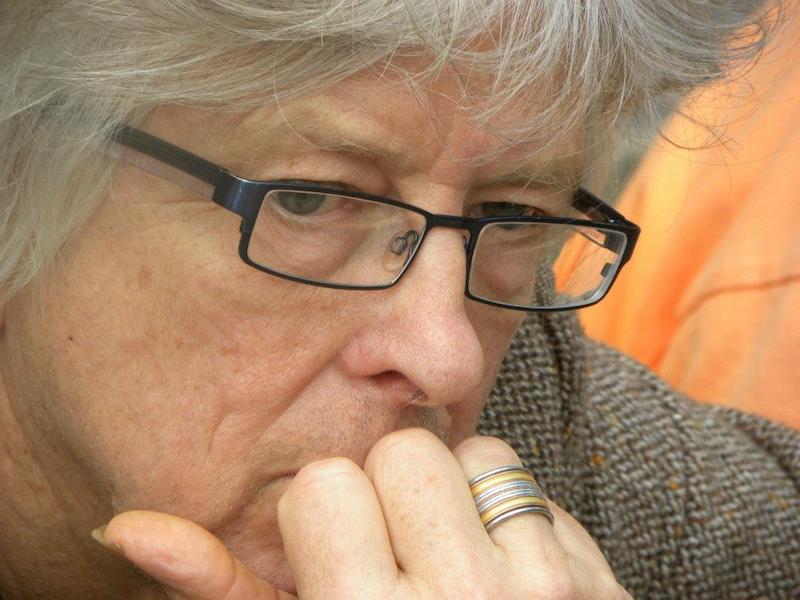Permaculture is a social movement founded in 1978 in Australia by Bill Mollison and David Holmgren. It has grown since then into a global movement for system change. While clearly a part of the broader environmentalist scene, permaculture is also distinctive in several ways. On the ground, permaculture activism is mainly connected to sustainable agriculture with a diversity of strategies designed to bring that about: projects for food security and landscape repair in the Global South, community supported agriculture cooperatives, ethical farming enterprises, backyard food gardening, community gardens. This activism is framed within a set of linked ideas that are expressed in the three fundamental texts of permaculture. Permaculture One, The Designers’ Manual and Permaculture: Principles and Pathways. ‘Energy descent’ implies that we will not be able to maintain energy abundance in an economy without fossil fuels. Permaculture offers itself as a systems approach to designing for sustainability in any context, not just in agriculture. Permaculture imagines a decentralised and egalitarian future as the way forward for post-industrial society and suggests a set of ethics to guide action. Care for the earth, care for people and distribute the surplus.
I first encountered permaculture in the late 1970s when Permaculture One (1978) was published. I had been a participant in the anarcha-feminist counterculture in Sydney since 1972. Some of the people in our childcare co-op organised to buy a rural property near Taree in NSW, to be run using permaculture ideas. This started me reading the permaculture material. I loved the idea of growing food plants in a forest, a diverse array of useful plants interacting together to suppress weeds and pests.
By the mid-1990s, I had been teaching the sociology of environment for a decade and had begun researching the views of Newcastle locals on the environmental crisis. Why were ordinary people so reluctant to embrace an environmentalist analysis? Why was there so little pressure on governments to do something about these problems? In 1996, I took the ‘Permaculture Design Certificate’. I studied with Liz Nicholson and Peter Wade at permaculture co-originator Bill Mollison’s property at Tyalgum, on the north coast of NSW. I started to attend permaculture convergences and participated in some of the organisational work of the Australian movement in this period.
In 2003, my permaculture interests broadened to include the experience of permaculture and other initiatives for sustainable agriculture in the global south. My university managed to get ten students into our Master of Social Change and Development programme. They were agricultural officers who worked in the rural villages of South Africa – where problems of malnutrition and unemployment were alarming. In later years, we had more students from other parts of Africa, and from other majority world countries, such as the Philippines, Pakistan and Mongolia. I visited the sites in Africa where our students were working, developing a subject on rural food security and project design. Two books and a documentary film came out of my research in the African villages.
My most recent research has been for the book The Politics of Permaculture (Pluto Press). It is a study of permaculture as a global social movement. It is based on a set of interviews with permaculture people from around the world and includes interview material from Indonesia and Africa as well as from the UK, Australia, the USA and Norway. This interview material is examined through the lens of my experience as a participant in the movement. I am interested in how the movement works in practice and in the way participants interpret the canonic texts of permaculture. As a part of the broader environmentalist movement, permaculture has concentrated on grass roots strategies which attempt to prefigure the economy and social life that we might expect in a future sustainable society. As a movement, it has not sought to influence policy through action on the state. This makes the permaculture movement an important case study for anyone who would like to see a transition to a sustainable future.
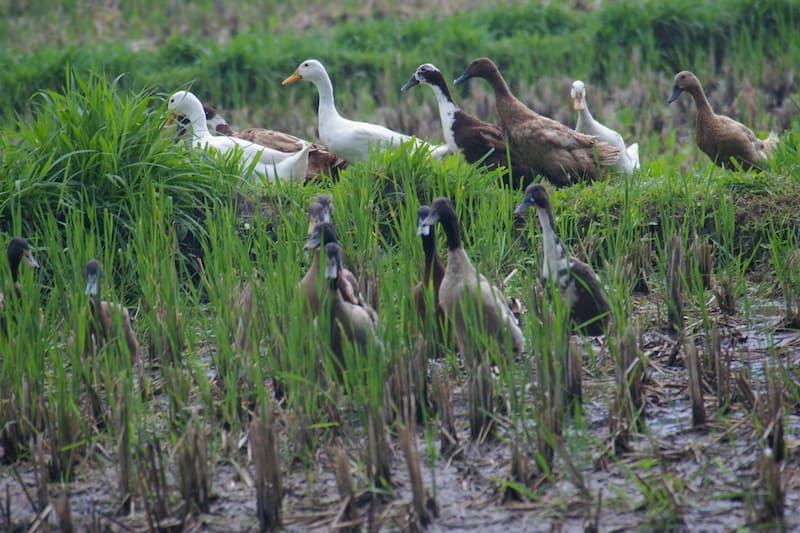
So, what are the politics of the permaculture movement? Co-founder Bill Mollison established permaculture explicitly in opposition to overtly ‘political’ practice. The influential series Global Gardener shows Bill walking across a misty paddock as we hear him recall:
In the late sixties, I was protesting social and environmental issues. But by the early seventies I decided that protest was not good enough. So, I commenced designing gardens and positive design systems for human settlements.
The next shot has him talking from his veranda, looking out at his garden in the subtropics:
If people only realized that everything they need is right outside their door. All you really need is sun, plants and keep your eye on the soil. And of course, if you’ve got plenty of fruit, you’ve got a lot of friends.
Not intending to repudiate the goals of the environmentalist and leftist movements, Mollison criticises the strategy of working towards the reform of the state. What makes more sense is to start to establish self-sufficiency through sustainable agricultural systems. We might well accuse Mollison of a breath-taking absence of reflection on what it is to live without the financial capacity to purchase your own land. In practice, permaculture activists have devised a variety of grass roots strategies to influence the use of land without requiring them to buy a farm. Mollison’s comment also makes no mention of the fact that the land he is talking about here in Australia has been stolen from Indigenous people. As recent critiques of permaculture point out.
Appreciating this read? Be sure to CHIP IN to help fund future articles from Green Agenda.
So how does this political strategy play out in the global permaculture movement today? Interviewing permaculture people in the last few years, I was struck by the variety of views on this. There were many who appreciated the anti-political approach of permaculture and its emphasis on grass roots activism to build the alternative. Jasmine from the UK permaculture movement talked about her exposure to leftist critique through university study and her subsequent discovery of permaculture:
I think that the political approach led me to understand the complexity of factors, and the scale of crises that ecosystems are at and how societies were dominated by institutions. Whereas Robin’s permaculture course did not even look at anything to do with that. It was just straight in — solutions. There we were learning, mulching, having tea with kangaroos. I was just empowered and optimistic and I think that’s one of the greatest gifts permaculture brings to things because it’s based on a strong understanding that all that stuff is happening in the world, but they don’t really put time into that. Let’s model driving ecosystems and you apply those principles in your design and let’s actually get stuff happening now.
Lachie, an Australian permaculture designer made a similar assessment of his permaculture landscaping business:
And it just made the most amount of sense, also for my mental health. I felt like I could actually make a tangible difference, that I could actually see, like even in one backyard at a time. It keeps me somewhat positive in what can be quite a negative situation.
While all participants in the movement are committed to the necessity for grass roots practical activism, many also looked forward to permaculture increasing its connection to other movements for social change, working with a variety of strategies. Andrew, a New York permaculture educator made the argument for the necessity for broad scale political change:
I think a myth that you’ll find in much of the permaculture material is that everybody needs to become their own permaculture gardener/farmer. And to me, that is delusional. We need to retrofit the infrastructure to be more regionally self-reliant. Redesigning altogether how food is grown, how energy is produced so that people don’t have to be thinking about these ecological values, who are consuming things.
Andrew means that people who are buying goods and services should not have to make an individual choice to prefer the sustainable product. Instead, this issue should be dealt with through a process of structural change and government intervention. The unsustainable product would not be an option. Permaculture designers should develop plans for regional self-sufficiency and become active in community forums to get them adopted. As a teacher he aims
product would not be an option. Permaculture designers should develop plans for regional self-sufficiency and become active in community forums to get them adopted. As a teacher he aims
to inspire people to study with us to feel they have a grasp of this scaled up application. So, their ability to take what is in the course and do something with it isn’t just about their individual life application. Have they learned ideas that they can go to different community decision boards with, and advocate for city wide initiatives?
A similar critique of the anti-politics associated with some permaculture activism was made by Alice, from a community supported agriculture farming cooperative in Wales, UK.
We need to be more outward looking. Organizing at a community level. I’m against the idea that permaculture is like loads of smallholders and their little kingdoms. I don’t see the point in that really.
Along with other members of the cooperative she was a participant in a land workers’ union in Wales and supported the Welsh nationalist party because of its land politics. She broadened this out to foresee changes to policy at a national level:
I think there needs to be land reform. It needs to be made a lot easier for people to do what we are doing, you know, and have a decent living out of it. There needs to be reform to transport, there needs to be reforms to energy, retrofitting.
Following the election here in Australia, we can see some similar sentiments in the movement. A number of permaculture leaders were enthusiastic about the outcome on their Facebook posts. Robyn made the following comment:
So relieved to see the results and the country voted for change. Thrilled to see such a strong swing to the Greens and the Teal independents and will be a different ballgame to what we’ve had this past decade. Hope they have a positive impact on Labour keeping their promises and much stronger action on climate change.
Russ posted:
The vote is a national rejection of the far-right numbies with their whinging culture wars and anti-science propaganda.
It is pertinent to recognize that a vocal minority within the permaculture movement do not share these sentiments. These ‘discontents’, as Patrick and Meg call their network, believe that the Green parties of the world (and much of the environmentalist movement), have been captured by corporatist elites. They see the pandemic response as the first step in implementing an authoritarian command economy run by big corporations. This grouping in permaculture does not expect the state to do anything useful to deal with the environmental crisis. Nevertheless, some have urged people to vote for minor parties to register their dissent.
Appreciating this read? Be sure to CHIP IN to help fund future articles from Green Agenda.
While these divisions are salient at the moment, it could be misleading to overestimate their long-term significance. A more interesting question is the kind of post-industrial system that participants in permaculture envisage. My interviews indicate a variety of scenarios for a post-industrial sustainable economy and political order. These reflect the diversity of opinion in the environmental movement taken as a whole.
A small minority of permaculture people look forward to a sustainable capitalism, based around the options allowed by digital communications technology. Petra from Indonesia began by making the comment that so long as people were working according to permaculture ethics the structures of social organisation did not matter. Digital technology would dismantle the top-down corporatist model, ‘I’m excited about technology and the potential technology has to establish communication and more socialist values’. Her colleague, Doni had a similar perspective, saying he was not worried by the dominance of the market economy. Capitalism ‘always adopts new things’, and sustainable businesses would prove their worth in the market. Other interviewees from around the world made occasional comments along these lines, but often in the context of quite different overall scenarios for a post-industrial future.
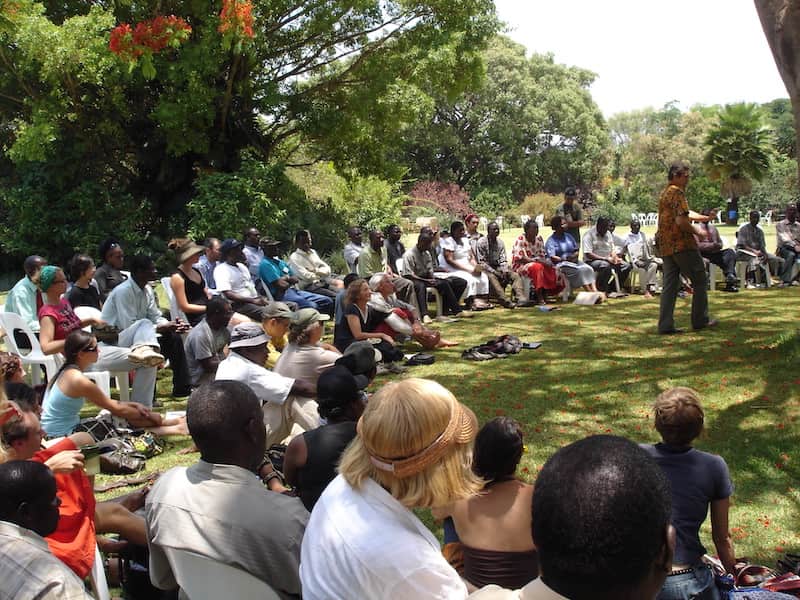
While this green capitalism strand is a minority view in permaculture there are two views which are much more common in the movement. One of these reflects the thinking in Mollison’s Designers’ Manual. Mollison suggests a rural population organized into bioregions, with democratic local governance. In that context, small ethical businesses would accompany workers’ cooperatives and community volunteering. Julie, from Melbourne, explained this framework. She proposes a permaculture society which is high tech (including the Internet) but low impact. It would not be a growth economy, but market transactions would still be the main mechanism for exchange. Settlements would integrate rural and urban functions. Each rural settlement would be largely self-sufficient in food. It would also specialise in some other function. For example, as an agricultural university, or manufacturing clothing, or making machine parts for vehicles. Transport would be via trains running on solar or wind power. Permaculture would become foundational and sustainable technologies would underpin all industrial production. Permaculture is neither left nor right, she argues. Instead, it promotes an idealistic vision.
Others talked about aspects of this scenario. For example, Karen from the United States cited her Ba’hai faith to explain why she believed a market economy could be guided by ethics. She argued that a local exchange trading scheme could replace national money to be the economic foundation for bioregionalism:
We’d be organising our economies more bioregionally. We’d be doing our thinking about what are the resources we’d need and how we’d produce those within this area.
Andrew, another permaculture activist from the United States presented a similar vision. A bioregional government could make broad planning decisions and install the underlying infrastructure for energy and transport. Production of food and industrial products can be largely localised to the bioregion. Energy production can take place within the bioregion and transport may run on that bioregional energy supply. Industrial production should be cradle to cradle, so that there is no toxic waste. Cities become sustainable. Organic waste can be treated through biodigesters, producing biogas to power homes and transport. Brown field sites will accommodate wind power, solar power and biodigester units. Food for a city will come from the urban periphery. We will have a market economy in which many people are not farmers and do not need to be self-sufficient. Instead, they can rest assured that all consumer goods have been produced sustainably.
The main way in which these visions depart from the Designers’ Manual is that they include sustainable cities as elements within a bioregional context of local energy provision, local agriculture and local governance. By contrast, Mollison did not believe that cities could ever become sustainable.
Another view of post-industrial society is also prominent in the movement, reflecting the politics of environmentalism at large. This scenario for post-industrial society envisages a much greater control and regulation of the market economy by the state. For example, resource taxes, a universal basic income, government funding for renewables, a monetary system more closely supervised by a government bank. For permaculture people the context for this state action is degrowth in the rich countries, with the long-term goal being a steady state economy. What is also envisaged are changes to a more bioregional governance, an increase in the role of cooperatives and community work, a system of localized currencies existing alongside national money. Policies such as these are dominant in the environmental movement and some well-known works debating these ideas are by Herman Daly, Richard Heinberg, Naomi Klein, Tim Jackson, Paul Mason, Kate Raworth and Jason Hickel.
A large proportion of permaculture activists made suggestions along these lines. Lachie from the Hunter region in NSW proposed a zero-growth economy. To prevent environmental damage, the government should place a monetary value on resources. The carbon tax (in Australia) was a move in the right direction. We should maintain a monetary market economy but legislate a four-day week – so people can maintain their voluntary community work. We need government regulation to spread paid work to all. The government should tax the rich to fund local development initiatives in countries where it is needed. Public money should go into clean energy and reafforestation. GDP is a flawed measure of economic health. A better measure would show how the economy is catering for people’s needs and looking after the environment.
Andy from the UK permaculture movement listed a similar set of policy proposals. Government policy should favour cooperatives rather than corporations. A more regional economy. Devolve most political decisions to a bioregional level. Shift from private transport to public transport and bicycles. Ban interest on loans. ‘We need to design the economy in a way that it doesn’t have to grow. So, it can be much more Steady State.’ Taxes may be used to curb environmental damage. State housing would be provided to housing cooperatives. Government funded workshops would facilitate voluntary community work, repairing bicycles, sewing, sharing tools and office equipment.
At the leftist end of the permaculture movement, a minority argue for a social democratic post-capitalism or for anarchist futures. For example, Damien from Newcastle, Australia, argued from a socialist perspective that we need to take control of the means of production.
Because still even if you work on your permaculture, you need the ownership of the means of production which might be the land. You still need a supportive state. A state that is co-opted in some way to the interests of that movement.
Naima, from Melbourne, endorsed an anarchist approach to post-capitalism.
I am definitely a mutual aid anarchist, not an everyone for themself anarchist. Ultimately to me there would be no money. I would prefer mutual aid and collectives. People doing what they can when they can and acknowledging when other people can’t do the same amount.
These divisions in the permaculture movement come from aspects of the movement that are quite typical of social movements. Sociologists refer to social movements as ‘polycephalous’, meaning that a social movement is not organized from one central point but from a diversity of centres of influence. These groupings share some key ideas and organize together on issues that require coordination. In their day-to-day operation, they remain autonomous. In this case, what unites permaculture people is the commitment to the canonic three texts of the movement and to the key ideas represented in those texts. An approach to sustainable agriculture and settlement design as popular science. Shared views on energy descent and degrowth. A shared commitment to grass roots organizing to implement sustainable agriculture and lifestyles in the here and now — as a pathway to system change. Clearly, within this shared framework, activists in the movement have a variety of ideas on how a post-industrial system would be organized.
An issue which has become a concern for many in the permaculture movement and for some postcolonial critics of permaculture is the extent to which permaculture perpetuates aspects of colonialist discourse and power structures. This became a topic in some of the interviews with permaculture activists that I conducted. Natalie, now working in Norway but originally from Australia, compared permaculture unfavourably with agroecology.
Permaculture doesn’t take into account indigenous and non-white voices. It still comes from a bit of a place of white privilege. I like agroecology’s approach – amplifying women’s voices, amplifying indigenous voices, and that emphasis on solidarity.
She was critical of the (white) permaculture community in Alice Springs for concentrating on their own permaculture gardens and sustainable lifestyles – while they played no part in working with the deeply disadvantaged Aboriginal community. Similar disquiet was registered by a number of the interviewees. These issues have become a focus of discussion and action. The 98th issue of the US-based Permaculture Design Magazine (2015) is devoted to ‘Decolonizing Permaculture’. A number of websites and organisations promote Indigenous or Black permaculture. For example, a 2019 convergence on the Pine Ridge Reservation. The theme was Indigenous wisdom and permaculture skills. Participants were assisting the Oglala Lakota Cultural and Economic Revitalization Initiative to address issues of ‘food scarcity, poverty, and lack of adequate housing’. Three main issues are addressed in the discussion in the movement.
1. The failure to acknowledge Indigenous knowledge as the basis of permaculture.
It is certainly true that many of the sustainable technologies of permaculture are drawn from traditional agricultural systems. In the earlier canonic texts, there is a patchy acknowledgement at best. For example, there is no mention of the fact that composting was a technology invented by Asian societies and brought to Europe in the nineteenth century. On the other hand, some technologies are linked to their traditional origins. For example, a food garden plan is acknowledged to be based on traditional designs from Hawaii and the Philippines. The third canonic book by Holmgren explains Aboriginal burning practices as a technology for a sustainable Indigenous economy. To an extent, agricultural science (by now a global intellectual property) is used to synthesize traditional technologies. For example, the nitrogen fixing capacity of legume plants, implemented in varied traditional agricultures. My view is that it makes sense for permaculture people to show respect by acknowledging traditional sources for agricultural technologies more adequately. The view that permaculture did not ‘invent’ sustainable agriculture — but draws on many aspects of traditional sustainable systems — is well taken and uncontroversial within the movement.
2. The domination of the movement by white people. The failure to be inclusive.
If in the rich countries, participants in the permaculture movement are mostly white and middle class, in the global south countries, permaculture has been quite successful with rural grassroots projects, where local people are in control. Discussion mostly concentrates on the situation in the rich countries.
Kirtrina Baxter, a Black woman from Philadelphia, is perplexed by the scarcity of people of colour in permaculture, asking ‘How is it that these permaculture principles speak to me, yet the movement does not?’ A working group at the 2014 USA permaculture convergence developed an action plan for a more inclusive permaculture with a list of advice. Insist on anti-oppression training sessions for permaculture convergences. Seek understanding about permaculture ideas that have their origin in Indigenous cultures and give proper credit. Facilitate separate social spaces in permaculture gatherings so people with a shared background can get together. Acknowledge when permaculture events are taking place on land stolen from Indigenous people. Seek invitations from Indigenous representatives. Give scholarships or reduce fees for people from Black or Indigenous backgrounds. These all make sense.
Many of the dynamics that exclude people of colour from permaculture are the same dynamics that exclude the white working class. Strategies premised on the purchase of agricultural land, the development of right consumerism and backyard farming are most accessible to the middle class. These have been the hallmark strategies of permaculture in the rich countries. Yet oppressed minorities are unlikely to see these strategies as an option for their communities. To break out of this box permaculture needs to expand on strategies which overcome these constraints. For example, in urban areas, permaculture activists may work at establishing community gardens. This can enable access to land for those who are not homeowners. Some of the permaculture activists that I interviewed were in fact involved in work of this kind. For example, Dave was a member of an NGO in the UK that had joined with local Muslim teenagers to set up a community garden in their town, to display food plants from other lands.
3. Settler ownership and Indigenous land.
Some participants in permaculture are ‘landowners’. In settler societies this means that the land that they own (whether residential or rural) was stolen from Indigenous people. In Permaculture Design Magazine,the ‘Decolonizing Permaculture’ issue includes this analysis by Jesse Watson: ‘Decolonization is about correcting past crimes committed by (mostly) European settlers by returning “stolen” land. Ideally, this process should be done without strings attached. Questions of what happens to present settler peoples is secondary to the act of returning Native land to Native peoples.’ One of my interviewees recommended reparations to First Nations people as part of an ideal permaculture society. Acknowledgement that the land we are using was stolen from Indigenous people is a necessary reminder at permaculture convergences while working to fully recognise Indigenous sovereignty.
Appreciating this read? Be sure to CHIP IN to help fund future articles from Green Agenda.
The broader vision of permaculture as a strategy for sustainability has important implications for postcolonial politics. The permaculture canonic texts, and participants in the movement, are committed to a strategy of localisation, including food, energy and transport. They are also convinced of the inevitability and necessity of energy descent (degrowth) to relieve the stress on the natural world. As critical social science has explained for decades, it is exploitation of the global south that is at the heart of the poverty and environmental damage being experienced in those countries. For example, in Australia we source everyday foods such as sugar, tea, coffee from the global south, along with industrial resources such as platinum, oil, rubber and the like. Permaculture suggests the rich countries localize food production and consumption and massively reduce the use of the earth’s non-renewable resources.
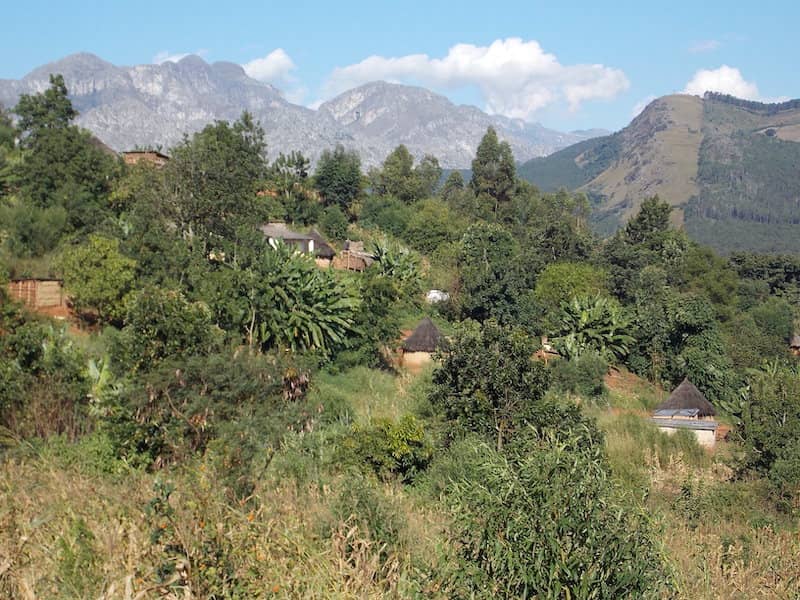
For projects in the Global South permaculture recommends self-sufficient localized food production, so that local people have a real choice about whether to be involved in globalized trade exchanges. For example, the Chikukwa project in Zimbabwe stresses local household provision and the technologies required to make that sustainable and nutritionally adequate. IDEP, the Indonesian permaculture organisation, helps people in remote parts of Indonesia to resist pressures to harvest their forests for logging — and suggests alternatives that allow them to protect their ancient environments.
To conclude this article, let us look in more detail at the grassroots strategies that are the distinctive hallmark of permaculture. This is grass roots activism that aims to ‘prefigure’ a desired new social system. In other words, the organizations that permaculture people set up are intended to resemble the kinds of organizations that will become dominant in a post-industrial sustainable society. Prefiguring strategies make use of the resources and affordances of society as it now is to create something different. In the case of permaculture, the options for ‘middle-class’ people in the rich countries to use some of their discretionary income and time, the possibility of establishing a small business, ownership of some residential or farming land, NGO funding for projects in the Global South, the time available to those without full-time work, sympathetic government support and so on.
The contribution of such strategies to system change can be seen in a number of different ways. One approach is to see these grass roots initiatives as gradually taking over the economic space now occupied by capitalist firms — and to see system change coming out of that. A less ambitious approach is to see this activism as ‘direct action’, taking over a part of the means of production and running it in a new way, regardless of any longer-term vision. Alternatively, we could say that the point is to model some aspects of a new system and to promote that vision. For example, to show people that you can supply food quite successfully without large industrial farms, toxic inputs, fossil fuels, land degradation, long distance transport and energy guzzling storage. Thinking like this, the expectation is that experiments of this kind promote a groundswell of new public opinion — leading to radical reforms or even a revolution to consolidate this new approach.
It can be useful to see these grass roots initiatives as hybrids of the gift economy and the capitalist market economy. On the gift economy side, there is some control of production by the workers or by the community more broadly. There is also some degree of distribution by ‘gift’, in other words without regard for monetary recompense. This distribution is intended to benefit particular people or the natural world, expressing the permaculture ethic of caring for people and the planet. These aspects of a hybrid are conjoined with aspects of the current capitalist market economy – for example, wage labour, the sale of the product as a commodity.
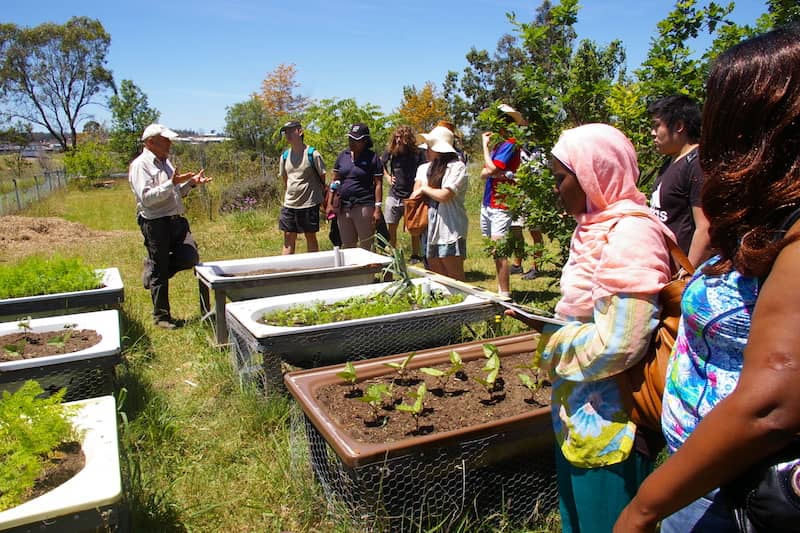
Let us look at an interview with Mark and Kate from Maitland in NSW. Kate bought her property on the edge of Maitland, a small rural town. This was about 20 years ago. Doing this, Kate and Mark were able to run their community supported agriculture (CSA) business with customers located in the town. These are some of the market aspects of this hybrid. Their property is privately owned, has a real estate value and can be sold on the market. Mark and Kate are self-employed business owners selling a commodity in competition with other firms. In particular, with the various supermarket chains operating in Maitland. They also sell educational services, teaching permaculture and hosting visits. For example, visits by ‘mums and bubs’ to see a real farm working. Their customers are buying food as a commodity using income generated through wage labour. They compare prices and decide what is in their price range.
The following are some of the gift economy aspects of this operation. Mark and Kate are running their operation as a small cooperative, choosing work that they find creatively fulfilling, even if it is often exhausting. Their business is an expression of permaculture ethics. They are growing food sustainably, giving back to the planet by increasing the biodiversity of their small holding, using solar energy and composting toilets in their house, harvesting their own water supply. Their customers are giving to the planet by supporting this sustainable technology for providing some of their food. They are sacrificing convenience in using only vegetables in season and receiving a random box according to the time of year and in driving to the pick-up point every week. At various times the farm has relied on Willing Workers on Organic Farms, in other words, on volunteers who contribute without being paid as wage labour. At the present time, apprentices are providing extra labour at key times of the yearly cycle and receiving instruction, a non-monetary aspect of the educational exchange.
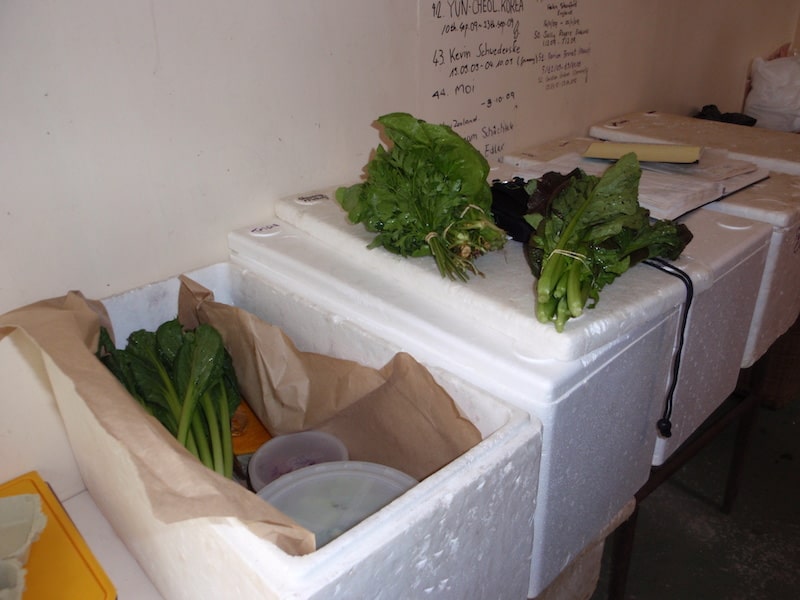
We can also look at the constraints created by the surrounding market environment. In the period when the CSA was in full production, Mark and Kate were selling weekly vegetable boxes (with eggs) for $25 per box. In other words, at rock bottom prices compared to supermarket prices for organic food. To an extent these low prices were a necessity to attract customers to forgo various kinds of convenience in their food purchasing. This low income means that Mark and Kate were living well below the level of consumer affluence that they might expect given their skills and background. More pertinent perhaps is the ultimate fate of this farm and its permaculture infrastructure. Real estate development has moved out to occupy this fringe and council rates have gone up accordingly. The prices for rural land on the periphery of Maitland have become unaffordable.
I actually got an inheritance from my dad. So, we were able to pay it off. I think that in our times now, for somebody young, to try and make a living from a permaculture farm is going to be quite difficult because they’ve got the cost of the land and they’ve got to pay it back.
Mark and Kate have no succession plan, their own children do not want to follow them into this business. It is understandable that their children will expect to receive the full value of their inheritance by selling the farm. Mark and Kate believe that permaculture people should join together to form land-buying cooperatives so that the next generation have a chance to start up local alternatives to agribusiness. This has not yet happened.
It is possible to make a similar analysis of all the grass roots initiatives described by my permaculture interviewees. My reading of this research is this. First, that the permaculture strategy of grass roots prefiguring works and makes sense. And second, the difficulties that these initiatives encounter also demonstrate the problems in achieving sustainability in the context of the market economy we now have.
It is unlikely that the global flowering of the permaculture movement could have taken place without the initial anti-politics framing. Mollison’s dramatic posing of the issues has driven a wave of experiments in grass roots initiatives in sustainable agriculture. Many have gone down this path because of frustration with political action that rarely results in big changes. They have been turned off by a politics that talks about a future sustainable society without being able to implement it. What is now happening is that permaculture people are deepening their analysis by producing a variety of models of system change that draw on different currents in the environment movement and the left. In addition, there has been a much greater understanding that we need to ally permaculture to other movements proposing system change — in order to get deeper structural changes in the economy and politics. This is a conversation that is just beginning.
If you appreciated the read, be sure to CHIP IN, even as little as $5, to help fund future articles.
For those reading this who may like to know more or to participate in permaculture in one way or another, let me recommend beginning with the book by Rosemary Morrow, The Earth Users’ Guide to Permaculture. This was recommended without solicitation by many of my interviewees. The peak body in Australia, Permaculture Australia, hosts lists of teachers who can provide instruction in the Permaculture Design Certificate – the main certification for permaculture training. There are also free introductions to permaculture provided by some local clubs and community centres.
About the author:
Terry Leahy lives in Melbourne, having retired from his academic position at University of Newcastle at the end of 2016. Between 1974 and 1988 he worked at the University of NSW in Sociology and from 1990 to 2016 at the University of Newcastle.
Terry Leahy’s current writing and research investigates three related topics: sustainable agriculture and food security; the global environmental crisis; and the philosophy of the social sciences. His work is framed by a critique of capitalism and patriarchy.
His most recent publications include a study of permaculture as a social movement The Politics of Permaculture; a sociological analysis of food insecurity in Africa, Food Security for Rural Africa: Feeding the Farmers First; a documentary on a permaculture project in Zimbabwe, The Chikukwa Project; and a book on social theory, Humanist Realism for Sociologists.
